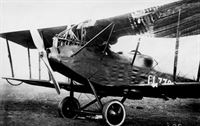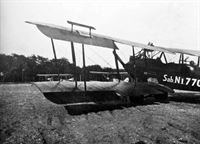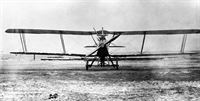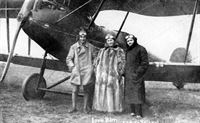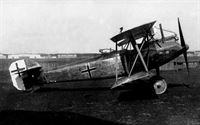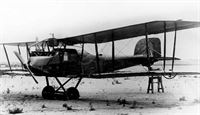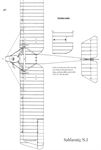
Описание
Страна: Германия
Год: 1917
O.Thetford, P.Gray German Aircraft of the First World War (Putnam)
Sablatnig C I
Built during 1917, the Sablatnig C I was a conventional C type two-seater of wood and fabric construction. At least two aircraft were built, Nos. 7700/17 (illustrated) and 7702/17, which served as prototypes for the subsequent N 1 type. The vee cut-outs in the trailing edge of the lower wings are usual - and unexplained. The lights built into the leading edge of the upper wing should be noted. Six 50 kg. bombs could be carried. Engine, 180 h.p. Argus As III. Span, 160 m. (52 ft. 6 in.). Length, 8.7 m. (28 ft. 6 1/2 in.). Weights: Empty, 1,050 kg. (2,310 lb.). Loaded, 1,540 kg. (3,380 lb.). Speed, 120 km.hr. (75 m.p.h.). Climb, 1,000 m. (3,280 ft.) in 9 min., 2,000 m. (6,560 ft.) in 20 min. Armament, one Parabellum machine-gun.
Sablatnig C II
Built round the 240 h.p. Maybach engine during 1918, the Sablatnig C II remained only an experimental prototype. The wings were braced with two bays of I-struts, and the fuselage and vertical fin were ply-covered. In many respects the machine favoured the SF 7 seaplane, the inboard wing bay being braced in identical manner. Engine, 240 h.p. Maybach Mb IV. Span, 12.5 m. (41 ft. 0 1/4 in.). Length, 8.3 m. (27 ft. 2 3/4 in.). Height, 3.2 m. (10 ft. 6 in.). Weights: Empty, 1,070 kg. (2,354 lb.). Loaded, 1,600 kg. (3,520 lb.). Speed, 150 km.hr. (93.75 m.p.h.). Climb, 1,000 m. (3,280 ft.) in 4.5 min., 5,000 m. (16,400 ft.) in 30 min. Range, 525 km. (328 miles). Armament, one Parabellum and one Spandau machine-guns.
Sablatnig Experimental C Type
These two machines were variants of the C II machine in an obvious endeavour to compare the advantages of the more normal parallel strut arrangement (above) with the I-strut system of the C II. For further comparison the X-strut cellule (below) was tried, this machine also differing in having overhung balanced elevators. Although not confirmed, dimensions were doubtless largely the same as those for the C II. Engine, 245 h.p. Maybach Mb IV.
Sablatnig N I
Built during 1918 to the N specification (which was first devised in August 1917), calling for a single-engined two-seat night bomber, the Sablatnig N I bore more than a passing resemblance to the C I. Probably a short series was constructed, as Serial Nos. 7729/17 and 7730/17 have been noted in addition to 7745/17 (illustrated above). Engine, 220 h.p. Benz Bz IV. Span, 16.0 m. (52 ft. 6 in.). Length, 8.7 m. (28 ft. 6 1/2 in.). Height, 3.2 m. (10 ft. 6 in.). Weights: Empty, 1,190 kg. (2,618 lb.). Loaded, 1,860 kg. (4,092 lb.). Speed, 125 km.hr. (78.125 m.p.h.). Climb, 1,000 m. (3,280 ft.) in 10 min., 4,000 m. (13,120 ft.) in 59 min. Armament, one Parabellum and one Spandau machine-guns.
Описание:
- O.Thetford, P.Gray German Aircraft of the First World War (Putnam)
- J.Herris Development of German Warplanes in WWI (A Centennial Perspective on Great War Airplanes 1)
- J.Herris Nachtflugzeug! German N-types of WWI (A Centennial Perspective on Great War Airplanes 3)
Фотографии
-
J.Herris - Nachtflugzeug! German N-types of WWI /Centennial Perspective/ (3)
Sablatnig N.I 7705/17; the colors and pattern of this profile are conjectural and based on the available photographs.
-
J.Herris - Nachtflugzeug! German N-types of WWI /Centennial Perspective/ (3)
Sablatnig N.I(Bz) 7730/17; the colors and pattern of this profile are conjectural and based on the available photographs.
-
J.Herris - Nachtflugzeug! German N-types of WWI /Centennial Perspective/ (3)
Sablatnig N.I(Bz) 7745/17; the colors and pattern of this profile are conjectural and based on the available photographs.
-
J.Herris - Nachtflugzeug! German N-types of WWI /Centennial Perspective/ (3)
Sablatnig C.I 7700/17 was the first of five Sablatnig C.I aircraft built. Landing lights were built into the upper wing for night operations and the bomb load of six 50 kg PuW bombs was that specified by Idflieg for single-engine night bombers, leading to the conclusion that it was designed to meet that specification. Interestingly for such a slow aircraft, it features a nicely-streamlined nose with propeller spinner. The large wings to lift the 300 kg bomb load are prominent, and ailerons were fitted to all wings. Skids under the wingtips help protect them from rough night landings. The Sablatnig N.I was developed from the Sablatnig C.I through a series of modifications.
-
J.Herris - Nachtflugzeug! German N-types of WWI /Centennial Perspective/ (3)
Sablatnig C.I 7702/17 was the third of the five C.I aircraft built. The spinner of the first prototype has been omitted, giving it a more utilitarian appearance. The servo-tabs on the ailerons are visible; these reduced the pilot's control forces to reduce his workload and improve maneuverability.
-
J.Herris - Nachtflugzeug! German N-types of WWI /Centennial Perspective/ (3)
This view of Sablatnig C.I 7702/17 emphasizes its similarity to the Sablatnig N.I. Dark camouflage has been applied for night operations.
-
J.Herris - Nachtflugzeug! German N-types of WWI /Centennial Perspective/ (3)
Sablatnig C.I 7703/18 was the fourth of the five C.I aircraft built. The lack of a spinner on the aircraft likely made little or no performance difference compared to the first C.I prototype given how slow these aircraft were. Unlike the first C.I, the landing lights are now in the lower wings.
-
J.Herris - Nachtflugzeug! German N-types of WWI /Centennial Perspective/ (3)
Nose and engine details of one of the last four Sablatnig C.I aircraft are shown in this damaged photograph. The landing lights are in the leading edge of the lower wings. All the C.I aircraft wore dark camouflage for night operations.
-
J.Herris - Nachtflugzeug! German N-types of WWI /Centennial Perspective/ (3)
Sablatnig C.I 7704/18, seen here without its wings, was the last of the five C.I aircraft built. Like the other C.I aircraft, dark camouflage has been applied for night operations. Did the factory painter make a mistake with the serial number? The number 7704 is part of the block of five numbers for the C.I, but the year suffix for that block is '/17', whereas the suffix here is '/18', which appears to be a mistake also made on 7703/18.
-
J.Herris - Nachtflugzeug! German N-types of WWI /Centennial Perspective/ (3)
One of the last four Sablatnig C.I aircraft is ready for takeoff. The aircraft looks very much like the Sablatnig N.I.
-
J.Herris - Nachtflugzeug! German N-types of WWI /Centennial Perspective/ (3)
Sablatnig N.I 7705/17 was the first Sablatnig N.I built; it was derived from the earlier, similar C.I aircraft. As evident from the photo, the N.I was a large two-seater of conventional design and construction. The wings and horizontal tail are covered in lozenge camouflage fabric in night colors; even the rudder is dark. The large designation and serial number painted in white on the fuselage aids identification but compromises the dark, night-bomber camouflage. There is a cutout in the left lower wing to clear the fins of a large bomb, an alternative load to the specified six 50 kg PuW bombs.
-
J.Herris - Nachtflugzeug! German N-types of WWI /Centennial Perspective/ (3)
This close-up view of Sablatnig N.I 7705/17 clearly shows the servo tab mounted above the aileron on the upper wing to reduce control forces. Ailerons are fitted to all wings with an actuating strut connecting upper and lower ailerons. The long exhaust pipe exhausts above the upper wing to avoid ruining the pilot's night vision. The cut-out in the lower left wing near the fuselage to clear the fins of a large bomb, an alternative load to the specified six 50 kg PuW bombs, may have been unique to this aircraft.
-
J.Herris - Nachtflugzeug! German N-types of WWI /Centennial Perspective/ (3)
This front view of the Sablatnig N.I, 7705/17 shows the landing lights, now in the lower wings, fitted to assist night landings. The overall clean fuselage lines are somewhat spoiled by the massive radiator in front of the upper wing. Skids under the lower wing protect the structure from mediocre landings at night.
-
J.Herris - Nachtflugzeug! German N-types of WWI /Centennial Perspective/ (3)
A mid-production machine, Sablatnig N.I(Bz) 7730/17 shows that even the engine cowling and fuselage are covered with printed camouflage fabric in night colors. The large type designation and serial number on the fuselage are now in outline from, which is much less obvious at night, but now the rudder is painted white, compromising its night camouflage. Interestingly, the type designation and serial number are repeated on the rear fuselage at more normal size. The skid under the lower right wing to protect it against rough night landings is clearly visible.
-
J.Herris - Nachtflugzeug! German N-types of WWI /Centennial Perspective/ (3)
A late-production machine, Sablatnig N.I(Bz) 7745/17 reverted to the large type designation and serial number on the fuselage in solid form but retained the white rudder, further compromising its night camouflage. The normal size type designation and serial number are now moved to the fin. The skid under the lower wing for night landings is clearly visible as is the servo tab above the upper aileron.
-
M.Dusing - German Aviation Industry in WWI. Volume 2 /Centennial Perspective/ (85)
Sablatnig Sab N.I (Bz stands for Benz) (1917)
-
J.Herris - German Seaplanes of WWI /Centennial Perspective/ (15)
A Sablatnig N.I provides the background for a group portrait at Flugstation Barde.
-
J.Herris - Nachtflugzeug! German N-types of WWI /Centennial Perspective/ (3)
This Sablatnig N.I was used as an airliner post-war; notice the landing lights in the lower wing. The unknown pilot is at the left; Lore Birn, the woman in the center, is the wife of the man on the right, famous Austrian actor Ludwig Stossel. Being Jewish, Stossel and his wife fled to England in the late 1930s, then reached Hollywood in 1939. Among many roles he appeared in the movie Casablanca (as Mr. Leuchtag) and played Lou Gehrig's father in Pride of the Yankees.
-
J.Herris - Nachtflugzeug! German N-types of WWI /Centennial Perspective/ (3)
Sablatnig N.I 7713/17 is shown post-war in civil DLR colors with military insignia still applied.The post-war Sablatnig P.I and P.II passenger airplanes were derived from the N.I, but like most other German airplane manufacturers the Sablatnig company went bankrupt in the 1920s, as intended by the Allies under the terms of the Armistice.
-
J.Herris - Nachtflugzeug! German N-types of WWI /Centennial Perspective/ (3)
This interesting photo shows the Sablatnig C.III monoplane on the left, one of the C.II biplane prototypes in the middle, and a production N.I on the right, making for an interesting picture of Sablatnig design evolution. Although the C.II is smaller and more compact than the N.I, it retains most of its design features other than the strut configuration. On the other hand, the C.III is a major advance. Although the C.III retains the basic fuselage and tail design of the earlier types, its low-wing monoplane design had much less drag; its frontal radiator also reduced drag.
Другие самолёты на фотографии: Sablatnig C.III - Германия - 1918
-
J.Herris - Nachtflugzeug! German N-types of WWI /Centennial Perspective/ (3)
The Sablatnig C.II was a more compact, powerful development of the C.I and N.I. Powered by a 240-245 hp Maybach Mb.lVa engine, it retained the bulky, high-drag radiator in front of the upper wing and was too slow to receive a production order. It was produced in several versions; this is the version with I-struts. All versions featured ailerons on all wings connected by an actuating strut and additional struts running from the upper longerons to the lower wings. The aileron servo tabs above the upper wing used by the N.I were retained by the C.II. The stubby exhaust is at the level of the crewmen's faces, clearly not pleasant for the crew.
-
M.Dusing - German Aviation Industry in WWI. Volume 2 /Centennial Perspective/ (85)
The experimental Sablatnig C.II Two-seater Tractor Biplane C II. (240 h.p. Maybach Mb IV engine.)
-
J.Herris - Nachtflugzeug! German N-types of WWI /Centennial Perspective/ (3)
By 1918 rubber was scarce in Germany and the tires of this prototype may have been scavenged for another aircraft.
-
J.Herris - Nachtflugzeug! German N-types of WWI /Centennial Perspective/ (3)
Front view of the Sablatnig C.II version with I-struts show more of its features. The slanting struts from the fuselage to the base of the inboard interplane I-struts eliminated the need for bracing wires for the inboard bay.
-
J.Herris - Nachtflugzeug! German N-types of WWI /Centennial Perspective/ (3)
Rear view of the Sablatnig C.II version with I-struts show more of its features.
-
J.Herris - Nachtflugzeug! German N-types of WWI /Centennial Perspective/ (3)
One of several versions of the Sablatnig C.II, this was the version with conventional, parallel inter-plane struts. The exhaust has been lengthened on this aircraft to move the gases away from the crew.
-
J.Herris - Nachtflugzeug! German N-types of WWI /Centennial Perspective/ (3)
One of several variations of the Sablatnig C.II, this is the version with X-struts. The bracing wires between bays appear to be connected at their intersections; this would reduce wire vibration, thereby reducing drag. The additional struts running from the upper longerons to the lower wings are clearly visible and appear to eliminate the need for bracing wires on the inner bay. The exhaust exits above the upper wing to protect the crew.
-
J.Herris - Nachtflugzeug! German N-types of WWI /Centennial Perspective/ (3)
Postwar, the Sablatnig N.I was developed into the P.I passenger plane.
-
M.Dusing - German Aviation Industry in WWI. Volume 2 /Centennial Perspective/ (85)
This Sab P.I was modified by installing a passenger cabin. The pilot was still sitting in an open cockpit.
-
J.Herris - Nachtflugzeug! German N-types of WWI /Centennial Perspective/ (3)
Postwar the Sablatnig N.I was developed into the P.I and P.II passenger-carrying aircraft; a rear view of one of these aircraft is shown here.








